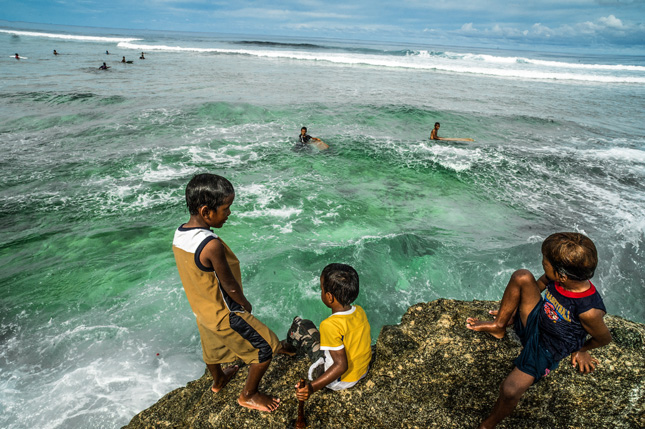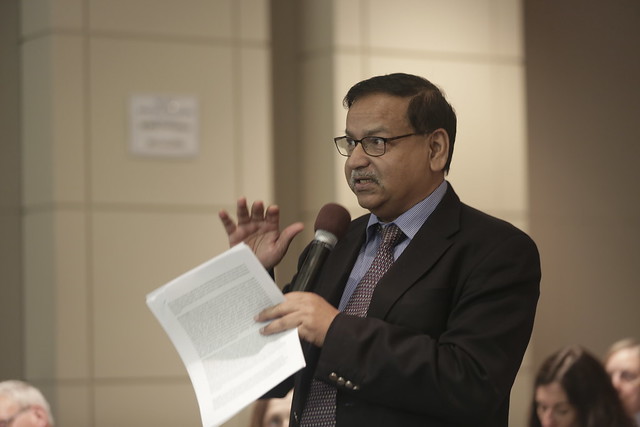-
From the Pacific to the Atlantic, Protecting Coastal Communities From Climate Threats
November 13, 2017 By Julianne Liebenguth
The frontlines of climate change are the world’s shorelines. “It goes without saying that people living in coastal communities are already observing impacts,” said Erin Derrington, a coastal resources specialist working in the Northern Mariana Islands, at a recent Wilson Center event, the third in a series on coastal resilience presented in collaboration with the Hoover Institute and the Stanford Woods Institute on the Environment. “Although that is a challenge, it is also an opportunity and a driver for change and innovation,” said Derrington.
The problem facing these vulnerable communities may get worse before it gets better. “Ecosystem-human impacts may interact in ways that become really, really difficult to control,” said Christopher Field, director of the Stanford Woods Institute for the Environment. “In particular, we face a risk of going from large but modest amounts of sea-level rise—less than a meter—to several meters, with the collapse of a major fraction of the Antarctic ice sheet.”
Reshaping the Environment in the Pacific Islands
Shoreline ecosystems are a critical component of the economy of coastal communities, particularly in low-lying island nations. In addition to physical resources—such as wetlands, coral reefs, mangroves, and wildlife habitat—coastal environments also include socio-cultural resources, said Derrington. Historical sites, scenic views, water sports, and public beaches contribute to economic productivity and livelihoods, particularly in areas that depend on tourism.
However, rising temperatures and changing rainfall patterns are reshaping human-environment relationships. Many communities in the Pacific islands, for instance, are grappling with periodic flooding, drought, water insecurity, and food disruptions, said Derrington, who is currently working in Saipan, a U.S. island territory. But such environmental stressors, she said, can also make coastal community members more receptive to conversations “about how we can build resilience of our ecological, social, and economic systems, which are of course integrally connected.”
One of the lowest lying island states in the world, the Marshall Islands is exceedingly vulnerable to sea-level rise, said Kees van der Geest, a researcher with University of Hawaii and the UN University Institute for Environment and Human Security. Intensifying tidal waves on the Marshall Islands have caused flooding and higher salinity levels in the soil and freshwater supplies, he said, which “affects people’s health, food security, [and] livelihoods,” he said.
At the same time, many Marshallese are migrating to the United States in search of better economic and educational opportunities, said Geest, whose research focuses on the links between migration, climate, and perceptions of adaptation. Although remaining Marshallese are worried about their circumstances, “they are hopeful that between now and the future, when climate change really becomes an existential threat . . . there will be solutions for them,” he said. “They really resist the idea that, someday, their islands are going to become uninhabitable and that they would be forced to move.”
Climate Threatens Human, National Security
As the climate changes, so do the risks of conflict and loss of lives and livelihoods. The devastating hurricanes in the Atlantic basin show that the impacts of climate change pose an existential threat for small islands and other coastal nations.
Researchers predict that climate change impacts will exacerbate political instability and act as a “catalyst for conflict.” But conflict also makes it harder to adapt to climate change: “There is a really important way that conflict creates phenomenal vulnerability to climate change impacts,” said Katharine Mach, a research scientist at Stanford University who is currently working on a project that assesses climate change and the risks of violent conflict. Therefore, “enabling peace is about creating adaptive capacity,” she added.
Climate change threatens our biosecurity, too, as rising temperatures can lead to the spread of vector-borne diseases such as dengue fever, chikungunya, and Ebola, said Alice Hill, a research fellow with the Hoover Institute and a former national security advisor to President Barack Obama. However, traditional security agencies are still a long way from fully accounting for climate-induced risks to stability, health, and safety, said Hill. “We are still at that dichotomy of human security and national security.”
Innovative Governance Can Build Coastal Resilience
Jurisdictional boundaries and regulatory inefficiencies can be impediments to effective environmental legislation. Several panelists pointed to alternative pathways that could enhance resiliency in vulnerable coastal communities.
In the Northern Mariana Islands, Derrington seeks to reduce risks associated with coastal development by implementing innovative regulations that require coastal developers to consult with zoning and public works offices early in the building process and identify opportunities for using more resilient infrastructure, such as permeable pavement and rooftop gardens. When developers fail to adopt best management practices, said Derrington, violators may implement supplemental environmental projects in exchange for reduced financial penalties, which incentivizes green infrastructure and “enhance[s] the resilience of the systems themselves more so than a dollar value might.”
Geest, who studies human mobility and climate adaptation, pointed out that migration facilitates remittances—money sent by family members who have relocated to other countries—to vulnerable areas, such as the Marshall Islands. Such money transfers and other migration-related exchanges can transcend national adaptation strategies and allow individuals to build local resilience.
Public-private partnerships also provide a platform for innovative adaptation. For instance, micro-insurance schemes can offer policies with premiums as low as one dollar a week to those who are most vulnerable to climate-induced disasters, said Thomas Loster, chairman of the Munich Reinsurance Foundation. Loster is also working on transferring risk through coastal resilience bonds that support investment in improving the health of coral reefs, which can ultimately reduce environmental risks, lower the overall cost of disaster-induced damages, and decrease insurance premiums.
Collaborative interaction among coastal stakeholders and across levels of governance—local, national, and global—is necessary to mitigate the future impacts of climate change. “It’s clear that we must protect the economy and infrastructure that protects our people,” said Jane Harman, president and CEO of the Wilson Center. “Whether we’re repairing bridges or rebuilding fragile states, we can only become resilient together.”
Sources: Commonwealth of the Northern Mariana Islands Coastal Resources Management Office, Marshall Islands Climate and Migration Project, Munich Reinsurance Foundation, The New York Times, Stanford Woods Institute for the Environment
Photo Credit: Children enjoying the day at the beach in Ebeye, an island within Kwajalein Atoll, August 2014, courtesy of the Asian Development Bank
 A Publication of the Stimson Center.
A Publication of the Stimson Center.




